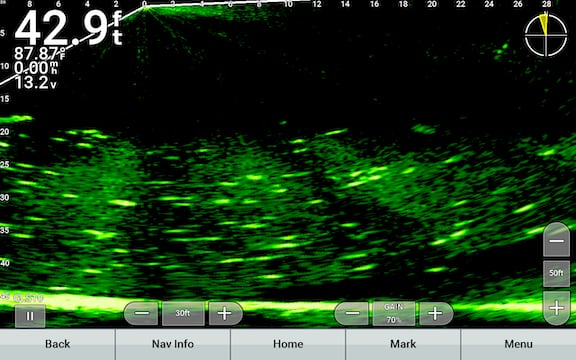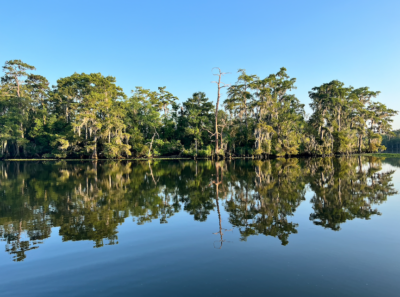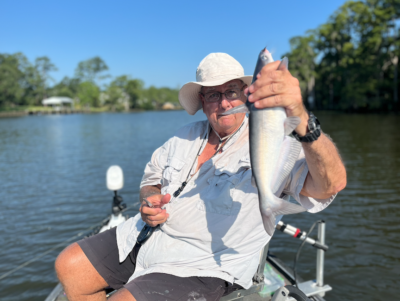Targeting Catfish with LiveScope
Keith Lusher 07.10.23

With crappie being one of the most challenging freshwater fish to locate and catch. Live-Imaging Sonar (LIS) is becoming more popular with anglers who are targeting these tasty fish. Ray Miller of Madisonville has been using Garmin LiveScope Sonar for three years now and he said he’s noticing something peculiar happening in the fishing community. “It seems that LiveScope has become synonymous with crappie fishing even to the point where guys don’t think you can use it for another type of fish,” he said. “There are other fish that show up on the electronic screen and I have no problem putting them in the ice chest right along with the sac-a-lait I catch.”
Miller has been primarily targeting crappie this summer but said the large schools of blue cats are becoming more and more common. So much so, that he has started making catfishing trips specifically targeting catfish.
I had the opportunity to make a trip with Miller to experience deep-jigging for these bottom feeders using LiveScope. We started our day early because of the forecasted high of 100 degrees. (What do you expect from South Louisiana in July) Miller launched his 16-foot flat boat in at the southern section of the Tchefuncte River. The Tchefuncte has a rich history of being a navigational river and its depth is one of its most appealing attributes, especially for crappie fishermen. After Miller launched his boat we headed upriver in search of a bend in the river that contained deep water. “The bends in the river are where you’re going to find deep water and that’s usually where the catfish are,” he said.

Miller’s set-up is a medium action rod with 12-pound monofilament line. He uses a 1/2oz. egg sinker that’s pegged about two feet above a #3 circle hook. On the hook, he threads on a piece of chicken liver. However, like most baits that he uses, Miller adds an extra ingredient. “I take the container of chicken hearts and livers and pour a pack of strawberry Kool-Aid in it and let it soak overnight,” he said. The sugar in the drink mix results in a hardening of the meat which allows it to stay on the hook longer.

As we lowered our lines down to the catfish. We could clearly see a school of them suspended at about 20 feet deep in a total of 40 feet of water. However, we quickly learned that it wasn’t going to be as easy as we would have liked it to be.
The problem was that the tide was slack and the river wasn’t moving at all, which is rare for the Tchefuncte River. “These fish are just like crappie, if there’s no water movement, they’re just not going to eat,” he said.

We then moved to a spot further north and found another bend with deep water. But much like the last spot, the catfish would turn up and look at the bait, then turn away. We continued to try different spots when Miller can upon a signature on his screen. It was a large group of shad swimming in a narrow, shallow line along a thermocline that was about 20 feet beneath the surface. Then Miller pointed something out. “Watch the catfish underneath those shad. He pointed to the screen and his finger followed a catfish charging up in the water column. The blue cat smashed through the shad, then returned to the other group of catfish that was hovering just below the group of baitfish. It was about 10:00 and the water was just starting to move on an incoming tide.
We lowered down our lines beneath the line of shad and finally one inhaled Miller’s chicken liver. A joyous eruption followed as this was a sign that the catfish were getting hungry. Miller reeled up a 14-inch catfish and netted it. As he was unhooking it he said, “These are the perfect sized catfish for eating. This is what we want right here,” he said. The reason being is that catfish, much like other fish, begin to develop bloodlines in the meat as they age. When they get around 20 inches you’ll start seeing the blood in the meat more. As we continued to catch the fish, the bite got more intense and we were putting catfish in the ice chest at a faster pace.

Unfortunately, the sun was beating down on us and it was already 98 degrees by 11:00 a.m. so we called it a day. We ended the day with 17 catfish measuring between 14 and 24 inches. But more importantly, I learned another way to put Live Imaging Sonar to work other than using it to hunt for crappie. Miller said there’s a ton of catfish in the river right now and LiveScope is an excellent way to target these fish and jokes, “Shhhh…don’t tell anyone you can catch catfish using Live Scope!”


